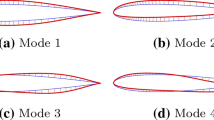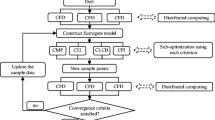Abstract
The formulation and implementation of a multidisciplinary optimization method called Simultaneous Aerodynamic and Structural Design Optimization (SASDO) is presented and applied to a simple, isolated, 3-D wing in inviscid flow. The method aims to reduce the computational expense incurred in performing shape and sizing optimization using existing state-of-the-art Computational Fluid Dynamics (CFD) flow analysis, FEM structural analysis and sensitivity analysis tools. Results show that the method finds the same local optimum as a conventional optimization method with as much as 50% reduction in the computational cost and without significant modifications to the analysis tools.
Similar content being viewed by others
References
N. M. Alexandrov and M. Y. Hussaini (Eds.),Multidisciplinary Design Optimization: State of the Art, SIAM Proceedings Series: Philadelphia, 1997.
Anon.,DOT Users Manual: Version 5.0,Vanderplaats Research & Development, Inc., Colorado Springs, May 1999.
E. Arian, “Analysis of the Hessian for aeroelastic optimization,” ICASE Report 95–84, Dec. 1995.
A. E. Arslan and L. A. Carlson, “Integrated determination of sensitivity derivatives for an aeroelastic tran-sonic wing,” inProceedings for the 5th AIAA/USAF/NASA/ISSMO Symposium on Multidisciplinary Analysis and Optimization,Panama City Beach, FL, Sept. 1994, pp. 1286–1300, also AIAA Paper 94–4400 CP.
G. Biros and O. Ghattas, “Parallel Newton-Krylov algorithms for PDE-constrained optimization,” inProceedings of Scientific Computing 99, Portland, OR, 1999.
C. H. Bischof, A. Carle, G. F. Corliss, A. Griewank, and P. Hovland, “ADIFOR: generating derivative codes from FORTRAN programs,”Scientific Programming vol. 1, no. 1, pp. 1–29, 1992.
C. Bischof and A. Griewank,, “ADIFOR: A FORTRAN system for portable automatic differentiation,” inProceed-ings of the 4th AIAA/USAF/NASA/OAI Symposium on Multidisciplinary Analysis and Optimization, Cleveland, OH, Sept. 1992, pp. 433–441, also AIAA Paper 92–4744 CP.
C. Bischof, W. T. Jones, J. Samareh-Abolhassani, and A. Mauer, “Experiences with the application of the ADIC automatic differentiation tool to the CSCMDO 3-D volume grid generation code,” AIAA Paper 96–0716, Jan. 1996.
O. Ghattas and J.-H. Bark, “Optimal control of two-and three-dimensional Navier-Stokes flows,”Journal of Computational Physics vol. 136, no. 2, pp. 231–244, 1997.
O. Ghattas and X. Li, “Domain decomposition methods for sensitivity analysis of a nonlinear aeroelastic problem,”International Journal of Computational Fluid Dynamics,vol. 11, pp. 113–130, 1998.
O. Ghattas, and C. E. Orozco, “Aparallel reduced hessian SQPmethod for shape optimization,” inMultidisciplinary Design Optimization: State of the Art,N.M.Alexandrov and M. Y. Hussaini (Eds.), SIAM Proceedings Series, Philadelphia, 1997, pp. 133–152.
A. A. Giunta, “Sensitivity analysis for coupled aero-structural systems,” NASA TM-1999–209367, Aug. 1999.
A. A. Giunta and J. Sobieszczanski-Sobieski, “Progress toward using sensitivity derivatives in a high-fidelity aeroelastic analysis of a supersonic transport,” inProceedings of the 7th AIAA/USAF/NASA/ISSMO Symposium on Multidisciplinary Analysis and Optimization, St. Louis, MO, Sept. 1998, pp. 441–453, also AIAA Paper 98–4763 CP.
C. R. Gumbert, G. J.-W. Hou, and P. A. Newman, “Simultaneous aerodynamic analysis and design optimization (SAADO) of a 3-D rigid wing,” inProceedings of 14th AIAA Computational Fluid Dynamics Conference,nor folk, June 1999, pp. 402–418, also AIAA Paper 99–3296.
C. R. Gumbert, G. J.-W. Hou, and P. A. Newman, “Simultaneous aerodynamic analysis and design optimization (SAADO) of a 3-D flexible wing,” AIAA Paper 2001–1107, Jan. 2001.
R. T. Haftka, J. Sobieszczanski-Sobieski, and S. L. Padula, “On options for interdisciplinary analysis and design optimization,”Structural Optimization,vol. 4, pp. 65–74, 1992.
G. Hou, S. Arunkumar, and N. S. Tiwari, “First-and second-order sensitivity analysis of finite element equations via automatic differentiation,” inProceedings of the 7th AIAA/USAF/NASA/ISSMO Symposium on Multidisciplinary Analysis and Optimization, St. Louis, MO, Sept. 1998, pp. 454–464, also AIAA Paper 98–4764.
G. J.-W. Hou, V. M. Korivi, A. C. Taylor, III, V. Maroju, and P. A. Newman, “Simultaneous aerodynamic analysis and design optimization (SAADO) of a turbulent transonic airfoil using a Navier-Stokes code with automatic differentiation (ADIFOR),” inProceedings of the Computational Aerosciences Workshop 95, W.J.Feiereisen and A. K. Lacer (Eds.), NASA CD CP-20010, Jan. 1996, pp. 82–85.
G. Hou and A. Satyanarayana,, “Analytical sensitivity analysis of a static aeroelastic wing,” inProceedings of 8th AIAA/USAF/NASA/ISSMO Symposium on Multidisciplinary Analysis and Optimization, Long Beach Sept. 2000, also AIAA Paper 2000–4824.
G. J.-W. Hou, A. C. Taylor, III, S. V. Mani, and P. A. Newman, “Simultaneous aerodynamic analysis and de-sign optimization,”Abstracts from 2nd U.S. National Congress on Computational Mechanics, Aug. 1993, pp. 130.
A. Jameson, and J. C. Vassberg, “Computational fluid dynamics for aerodynamic design: Its current and future impact,” AIAA Paper 2001–0538, Jan. 2001.
W. T. Jones and J. Samareh-Abolhassani,, “A grid generation system for multidisciplinary design optimization,” inProceedings of the 12th AIAA Computational Fluid Dynamics Conference, San Diego, June 1995, pp. 474–482, also AIAA Paper 95–1689.
R. K. Kapania, L. B. Eldred, and J.-F. M. Barthelemy, “Sensitivity analysis of a wing aeroelastic response,”Journal of Aircraft vol. 30, no. 4, pp. 496–504, 1993, also AIAA Paper 91–1103.
S. V. Mani,Simultaneous Aerodynamic Analysis and Design Optimization, Master's thesis, Old Dominion University, Norfolk, VA, Dec. 1993.
K. Maute, M. Nikbay, and C. Farhat, “Analytical based sensitivity analysis and optimization of nonlinear aeroelastic systems,” inProceedings of 8th AIAA/USAF/NASA/ISSMO Symposium on Multidisciplinary Analysis and OptimizationLong Beach, Sept. 2000, also AIAA Paper 2000–4825.
H. Møller and E. Lund, “Shape sensitivity analysis of strongly coupled fluid-structure interaction problems,” inProceedings of 8th AIAA/USAF/NASA/ISSMO Symposium on Multidisciplinary Analysis and OptimizationLong Beach, Sept. 2000, also AIAA Paper 2000–4823.
P. A. Newman, G. J.-W. Hou, and A. C. Taylor, III, “Observations regarding use of advanced CFD analysis, sensitivity analysis, and design codes in MDO,” inMultidisciplinary Design Optimization: State of the Art, N. M. Alexandrov and M. Y. Hussaini (Eds.), SIAM Proceedings Series: Philadelphia, 1997, pp. 263–279, also ICASE Report 96–16, NASA CR 198293 (available electronically at www.icase.edu).
J. C. Newman, III, A. C. Taylor, III, R. W. Barnwell, P. A. Newman, and G. J.-W. Hou, “Overview of sensitivity analysis and shape optimization for complex aerodynamic configurations,”Journal of Aircraft vol. 36, no. 1, pp. 87–96, 1999.
J. C. Newman, III, D. L. Whitfield, and K. W. Anderson, “A step-size independent approach for multidisciplinary sensitivity analysis and design optimization,” inProceedings of the 17th Applied Aerodynamics Conference, Norfolk, VA, June 1999, pp. 12–22, also AIAA Paper 99–3101.
D. T. Nguyen, “Finite element software for multidisciplinary design optimization, final report,” Tech. rep., Old Dominion University Research Foundation, Contract NAS1–19858, Task 69, NASA Langley Research Center, Hampton, VA, Nov. 1995.
N. A. Pierce and M. B. Giles, “Adjoint recovery of superconvergent functionals from PDE approximations,”SIAM Review vol. 42, no. 2, pp. 247–264, 2000.
J. J. Reuther, J. J. Alonso, J. R. Martins, and S. C. Smith, “A coupled aero-structural optimization method for complete aircraft configurations,” AIAA Paper 99–0187, Jan. 1999.
C. Rumsey, R. Biedron, and J. Thomas, “CFL3D: Its history and some recent applications,” NASA TM-112861, May 1997.
J. A. Samareh and K. G. Bhatia, “A unified approach to modeling multidisciplinary interactions,” inProceedings of the 8th AIAA/NASA/USAF/ISSMO symposium on multidisciplinary analysis and optimization, Long Beach, Sept. 2000, also AIAA Paper 2000–4704.
L. Sherman, A. Taylor, III, L. Green, P. Newman, G. Hou, and M. Korivi, “First-and second-order aerodynamic sen-sitivity derivatives via automatic differentiation with incremental iterative methods,”Journal of Computational Physics vol. 129, no. 2, pp. 307–336, 1996.
G. R. Shubin, “Application of alternative multidisciplinary optimization formulations to a model problem for static aeroelasticity,”Journal of Computational Physics vol. 118, no. 1, pp. 73–85, 1995.
R. E. Smith, M. I. G. Bloor, M. J. Wilson, and A. T. Thomas, “Rapid airplane parametric input design (RAPID),” inProceedings of the 12th AIAA Computational Fluid Dynamics Conference, San Diego, June 1995, pp. 452–462, also AIAA Paper 95–1687.
S. Ta'asan, “Trends in aerodynamic design and optimization: A mathematical viewpoint,” inProceedings of the 12th AIAA Computational Fluid Dynamics Conference, San Diego, June 1995, pp. 961–970, also AIAA Paper 95–0001.
A. C. Taylor, III, A. Oloso, and J.C. Newman, III, “CFL3D.ADII (Version 2.0): An efficient, accurate, general-purpose code for flow shape-sensitivity analysis,” AIAA Paper 97–2204, June 1997.
D. A. Venditti, and D. L. Darmofal, “Multilevel error estimation and grid adaptive strategy for improving the accuracy of integral outputs,” inProceedings of the AIAA 15th Computational Fluid Dynamics Conference, Norfolk, June 1999, also AIAA Paper 1999–3292.
J. L. Walsh, J. C. Townsend, A. O. Salas, J. A. Samareh, V. Mukhopadhyay, and J. F. Barthelemy, “Multidisciplinary high-fidelity analysis and optimization of aerospace vehicles, Part 1: Formulation,” AIAA Paper 2000–0418, Jan. 2000a.
J. L. Walsh, R. P. Weston, J. A. Samareh, B. H. Mason, L. L. Green, and R. T. Biedron, “Multidisciplinary high-fidelity analysis and optimization of aerospace vehicles, Part 2: Preliminary results,” AIAA Paper 2000–0419, Jan. 2000b.
Author information
Authors and Affiliations
Rights and permissions
About this article
Cite this article
Gumbert, C.R., Hou, G.JW. & Newman, P.A. High-Fidelity Computational Optimization for 3-D Flexible Wings: Part I—Simultaneous Aero-Structural Design Optimization (SASDO). Optimization and Engineering 6, 117–138 (2005). https://doi.org/10.1023/B:OPTE.0000048539.37526.e3
Issue Date:
DOI: https://doi.org/10.1023/B:OPTE.0000048539.37526.e3




